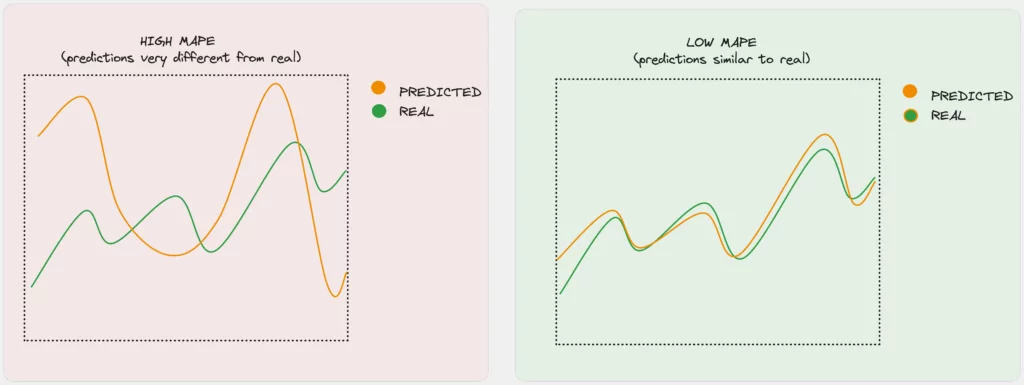
Noa Azaria
Today we’re going to delve into a vital metric called Mean Absolute Percentage Error, or MAPE for short. Understanding MAPE is crucial if you are dealing with forecasting models. So let’s get started!
Before jumping into calculations, let’s understand what Mean Absolute Percentage Error (MAPE) really is. In simple terms, it is a statistical measure that helps you determine how accurate your predictions or forecasts are in relation to the actual values. In forecasting models, such as time series analysis, it’s crucial to gauge the performance of your model, and MAPE offers a handy means to do just that. It expresses the error as a percentage, making it easier for you to interpret and communicate the model’s accuracy.

Knowing the importance of MAPE, the next step is to learn how to calculate it. It’s surprisingly simple!
The formula for MAPE is:

Where:
By iterating through each data point, calculating the absolute percentage error, and then averaging them, you obtain the MAPE. The result is a percentage indicating the average deviation of the predicted values from the actual values.
Now that you understand how to calculate MAPE, let’s explore how you can use it to measure the accuracy of your forecasting models.
However, keep in mind that MAPE has its limitations. It cannot be used when the actual values have instances of zero, as this would lead to division by zero in the formula. Additionally, MAPE can sometimes favor models that under-forecast.
In order to illustrate how MAPE can favor models that under-forecast, especially when forecast values approach zero, consider two scenarios:
Scenario 1 (Over-forecast with small actual value):
The MAPE in this case would be:
MAPE = (|10 - 20| / 10) * 100% = 100%
Scenario 2 (Under-forecast with small actual value):
The MAPE in this case would be:
MAPE = (|10 - 0| / 10) * 100% = 100%
In these two scenarios, the over-forecast has the same percentage error as the under-forecast.
However, if the under-forecast is very close to zero but not exactly zero, the MAPE is still high.
Let’s consider an extra scenario to illustrate this:
Scenario 3 (Under-forecast close to zero):
The MAPE in this case would be:
MAPE = (|10 - 0.0001| / 10) * 100% = 99.999%
But if the under-forecast is exactly zero, the MAPE is zero:
Scenario 4 (Under-forecast exactly zero):
The MAPE in this case would be:
MAPE = (|10 - 0| / 10) * 100% = 100%
Despite the actual value being 10, an under-forecast of exactly zero results in a MAPE of 100%. This is the reason why MAPE can sometimes favor models that under-forecast, especially when the forecast values are very close or equal to zero.
As with any metric, MAPE comes with its own set of limitations. Being aware of these will help you make better-informed decisions regarding when to use MAPE.
In light of these limitations, it is advisable to use MAPE in conjunction with other evaluation metrics such as Mean Absolute Error (MAE) or Root Mean Squared Error (RMSE) to get a more comprehensive understanding of your model’s performance. Additionally, it is important to consider the nature of your data and the specific requirements of your project when deciding on the metrics to use.
MAPE is not only useful for evaluating model performance but also for continuous monitoring of a model after deployment.
Understanding Mean Absolute Percentage Error (MAPE) is crucial for anyone in predictive modeling, particularly for evaluating and monitoring forecasting models. However, it’s imperative to recognize its limitations, such as inaccuracy near zero values and asymmetry. Thus, incorporating complementary metrics like Mean Absolute Error (MAE) or Root Mean Squared Error (RMSE) is advisable for a more comprehensive evaluation.
Being vigilant regarding your data’s nature and the specific requirements of your forecasting tasks will empower you to make informed decisions about which metrics to employ. I hope this article has shed light on MAPE, and I encourage you to stay curious and continue learning. Happy monitoring!